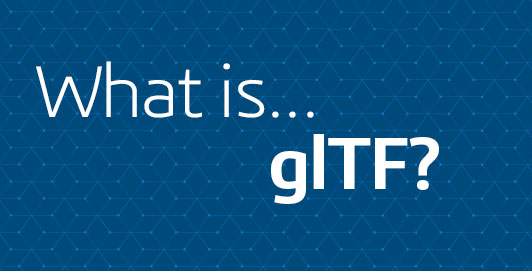
When shopping online, have you ever been frustrated by what you can’t see in the product photography? Or how long it takes to watch a product video, especially when it doesn’t answer your question? If so, you will appreciate glTF™, a new generation of online product experience that lets each shopper maneuver and customize a 3D computer model to see precisely what interests them.
So what is glTF? It’s the shorthand name for Graphics Language Transmission Format, a royalty-free standard for transmitting and displaying interactive 3D computer models on a web or mobile device. Click-and-drag across a glTF image and you can make it spin around or flip over. You can view it in different colors with different options. You can zoom in on specific features or virtually “explode” the product to display interior components. You can even place products – furniture, for example – into a photo or model of a room in your home using Augmented Reality (AR).
How glTF is used
glTF product models are beginning to appear on e-commerce sites, and the glTF standard has advanced to the point that shoppers will soon see it everywhere. Why? Because glTF is a game-changer for manufacturers and retailers who aim to deliver richer online product experiences, and for the consumers who buy them:
- Manufacturers use the same 3D engineering and design data for marketing their products as for manufacturing them, ensuring that what appears in their online marketing materials is always current and accurate. Those materials also are customized by market; if a configuration of an automobile, for example, isn’t available in a consumer’s market, it won’t be displayed to them. As manufacturers make changes to their products, updating what consumers see online can be done with a few clicks.
- Retailers benefit by providing accurate, 3D interactive content that helps their consumers find the products they want and need. Each consumer interaction with a glTF model also generates “digital exhaust”: real-time insights into consumer preferences that retailers use to refine their offerings. They also get early insights into emerging consumers trends, which their suppliers can use to update their product designs.
- Consumers benefit from an online product experience customized to their preferences. Instead of being offered one or two photos, for example, consumers can generate a model that incorporates their specific color and option choices. They can even place models of furniture, lighting, rugs and more into images of their own rooms – not some ideal room chosen by the manufacturer or retailer.
Experience a glTF product demo of a wristwatch
glTF at Dassault Systèmes
Tom Acland is CEO of Dassault Systèmes 3DEXCITE, the commercial brand of the 3DEXPERIENCE platform. 3DEXCITE is an active contributor to Khronos Group, the non-profit organization that develops and manages the glTF standard. 3DEXCITE has led the 3DS contribution to glTF standard development since 2017. Other prominent members include: Adobe, Amazon, Google, Ikea, Microsoft, Nvidia, Oculus, Target, Wayfair, and more.
“glTF has laid the groundwork for a 3D marketing revolution,” Acland said. “Much like the jpeg revolutionized the way we view images online, glTF is making it possible to view rich 3D material quickly and consistently across many different applications. This means new products, services and experiences will move from concept to marketplace faster than ever before. We’ll also deliver consumer satisfaction with fewer physical resources, which is good for the environment.”
Listen to Tom Acland explain glTF
What’s next for glTF?
Given the long history of 3D engineering, why has glTF content taken so long to arrive at online shopping sites? Because the engineering models that glTF exploits can consume terabytes of data – far too large for online use. Different design and engineering software packages also create models in different formats for different data viewers.
The Khronos Group’s latest release of glTF standardizes how these rich assets get converted to lightweight models that web browsers can support and ensures they are displayed consistently on any device.
So be on the lookout for glTF, coming soon to e-commerce sites everywhere.
Learn more about glTF

